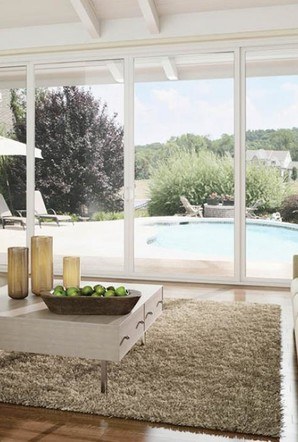If you’re upgrading your windows, you might be thinking about improving energy efficiency and saving money on heating and cooling bills. But what are the most energy-efficient windows? If you’re tired of drafts, inconsistent temperatures, or high utility bills, it’s time to learn about high R-value windows.
Ìý
Understanding the R-value of windows
The R-value of glass measures how well it resists heat flow. A higher R-value means the window provides better insulation. Put another way, heat naturally moves from warmer areas to cooler ones, and windows with a high R-value help prevent this heat transfer.Ìý
So what’s a good window R-value? Standard ENERGY STAR insulated glass R-values are usually about 3. This is good, but the highest R-value windows go up to a rating of 7. If you want maximum energy savings, look for at least R-5 windows. These windows offer excellent insulation and can help lower your energy bills over time, but are also relatively affordable.
Ìý
R-Value vs. U-Value
While the R-value measures resistance to heat flow, the U-value measures how much heat escapes through the window. They might seem like the same thing, but there’s a key difference. The R-value of windows focuses on how well the glass insulates, while the U-value considers the entire window—glass, frame, and all.
When choosing new windows, check both the R-value and the U-value to ensure you're getting the best possible energy efficiency. A high R-value window has good insulation, but you also want a low U-value, which means the window is good at stopping heat from escaping.Ìý
Ìý
Benefits of windows with a high R-value
The most obvious benefit of high R-value windows is energy savings. They provide excellent insulation, so your heating and cooling systems don’t have to work as hard. This reduces your energy consumption, which lowers your utility bills. Over time, the savings can offset the higher upfront cost of these windows.
Another benefit is increased comfort. With better insulation, you’ll have fewer drafts and more consistent temperatures in your home. This means no more cold spots near windows during the winter or overheated areas during the summer. The best insulated windows also contribute to a quieter home by reducing outside noise, thanks to the additional layers of glass and insulating gas between panes.
Ìý
How to choose the best high R-value glass and windows for your home
To choose the best R-value windows for your home depends on several factors, consider your budget, the features of the windows, and the type of glass and frame that work best for your climate and home style. Here’s how to make the right decision.
Ìý
Consider Your Budget
High R-value windows tend to be more expensive because of the advanced materials and manufacturing processes involved. Installation can also be pricier, because these windows are heavier and require professional installation.Ìý
However, over time, the energy savings can outweigh the upfront investment, especially if you live in an area with extreme temperatures. Keep this in mind when setting your budget, and weigh the long-term benefits against the short-term cost.
Ìý
Compare Window Specs
When comparing high R-value windows, take a close look at the specs. A higher R-value means better insulation, but balance this with the cost of the window. You may find that R-5 windows offer plenty of energy savings at a reasonable price, while an R-value of 7 might cost significantly more without providing a huge difference in performance.
Ìý
Choose Your Glass
The type of glass used in your windows has a big impact on their energy efficiency. One common feature that can improve the R-value of glass is Low-E (low emissivity) coatings, which reflect heat. They also block more UV rays, which can help prevent your furniture and carpets from fading.
Another factor to consider is the type of gas fill between the panes. Argon and krypton are the most commonly used. Krypton is more expensive but offers better insulation, while argon is more affordable and still provides good performance.
Ìý
Choose Your Frame
The material of the window frame also plays a crucial role in energy efficiency. Vinyl is a popular choice because it’s durable, affordable, and provides excellent insulation. It resists moisture and won’t warp or rot, making it a low-maintenance option. Vinyl frames can also be filled with insulating materials to further enhance their energy efficiency.
Other materials like wood and aluminum are available, but they have their pros and cons. Wood offers a traditional look and good insulation but requires regular maintenance. Aluminum is strong and lightweight but is less efficient in preventing heat transfer unless it has a thermal break. Vinyl often strikes the best balance between cost, durability, and energy efficiency, making it a top choice for many homeowners.
Ìý
ÐÓ°ÉPro Windows and Doors: Leading manufacturer of R-5 windows
The best R-value windows don’t have to be the highest rated. R-5 windows are the top tier of energy efficient windows with a whole-window U-Value of .22 or below. These windows are among the most efficient windows available today for all climates.
ÐÓ°ÉPro Windows and Doors has been named the leading manufacturer of R-5 windows by the Department of Energy. We have a proven track record of providing energy-efficient windows combined with feature-rich designs across the country. In our Western Region, the award-winning EnergyCore is one of the most energy-efficient windows on the market. In the Eastern and Southern regions, the feature rich V3000 Series provides a complete line of high R-value windows.
Want to learn more about the R-value of windows, or find the best insulated windows for your home? ÐÓ°ÉPro Windows and Doors has a team of Certified Dealers ready to answer all your questions and help you improve your home’s energy efficiency. Find a dealer near you today to get started.































